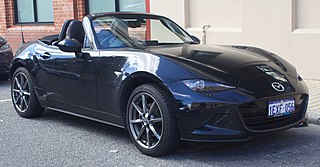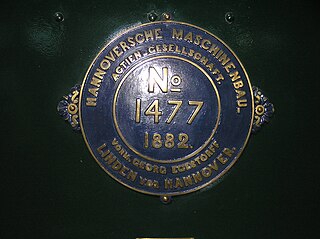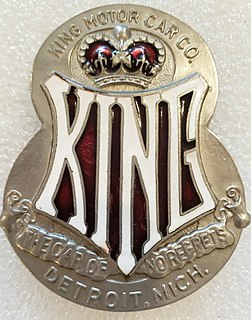
A roadster is an open two-seat car with emphasis on sporting appearance or character. Initially an American term for a two-seat car with no weather protection, usage has spread internationally and has evolved to include two-seat convertibles.

Touring car and tourer are both terms for open cars.

The Arab was a high-performance English automobile designed by Reid Railton and manufactured in Letchworth, Hertfordshire, between 1926 and 1928. The factory had previously been used by the Phoenix car company.

Trojan was a British automobile manufacturer producing light cars between 1914 and 1965, and light commercial vehicles for a short time.

A landaulet, also known as a landaulette, is a car body style where the rear passengers are covered by a convertible top. Often the driver is separated from the rear passengers by a division, as with a limousine.

A runabout is a car body style popular in the 1910s, based on the horse-drawn runabout carriage.

Hanomag was a German producer of steam locomotives, tractors, trucks and military vehicles in Hanover. Hanomag first achieved international fame by delivering numerous steam locomotives to Finland, Romania and Bulgaria before World War I and making of first tractor Hanomag R26 in 1924 in Germany. In 1925, they added automobiles to their line, additionally moving in 1931 into the production of construction machinery. Since 1989, the company has been part of the Komatsu company.
F. B. Stearns and Company, later known as F.B. Stearns Company was an American manufacturer of luxury cars in Cleveland, Ohio marketed under the brand names Stearns from 1900 to 1911 then Stearns-Knight from 1911 until 1929.

The Union automobile was a vehicle manufactured by the Union Automobile Company from 1902 until 1905. It was designed by John William Lambert, who had developed the three-wheel Buckeye gasoline buggy in 1891. Over the next decade, Lambert substantially refined the vehicle, with modifications including an additional wheel, a more powerful engine, and a new transmission system. The Union Automobile Company was formed as a subsidiary of Lambert's Buckeye Manufacturing Company solely to manufacture the Union, which took its name from Union City, Indiana, the city where it was built and which endorsed its production. In total, the company built over three hundred Union automobiles, before development shifted to the Lambert automobile, the Union's successor.

The Lambert automobile and Lambert truck were vehicles built from 1905 through 1916 by the Lambert Automobile Company in Anderson, Indiana, United States. The Lambert automobile was an outgrowth from the Union automobile made by the Union Automobile Company, a previous vehicle that was being manufactured by John William Lambert. The factory manufactured about 3,000 automobiles and trucks per year by 1915 and had several models ranging in price from $1,200 to $3,000 at the time. The vehicles came with a gearless friction drive transmission. The demise of the manufacture of automobiles and trucks came about because of World War I.
The King-Remick was a brass era automobile built in Detroit, Michigan, in 1910.

The Ariel was made by the Ariel Motor Car Company from 1905 to 1906 in Boston, Massachusetts, and, briefly, in Bridgeport, Connecticut.
The Austin was a brass era American automobile manufactured in Grand Rapids, Michigan from 1901 to 1921. The company, founded by James E. Austin and his son Walter Austin, built large, expensive and powerful touring cars with an unusual double cantilever rear spring arrangement placing the rear wheels behind the passenger compartment, for a longer wheelbase to improve rider comfort in an era of rough roads as well as a unique two-speed rear axle.

Western Tool Works was a pioneering brass era automobile manufacturer in Galesburg, Illinois. The company made Gale automobiles from 1904 to 1910. Early Gale runabouts were notable for having bodywork hinged at the rear of the car that could be lifted to ease access to the engine, essentially making the entire body the hood.

The Jackson Automobile Company was an American Brass Era automobile manufacturer located in and named for Jackson, Michigan. The company produced the Jackson from 1903 to 1923, the 1903 Jaxon steam car and the 1904 Orlo.
Continental Motors Company was an American manufacturer of internal combustion engines. The company produced engines as a supplier to many independent manufacturers of automobiles, tractors, trucks, and stationary equipment from the 1900s through the 1960s. Continental Motors also produced automobiles in 1932–1933 under the name Continental Automobile Company. The Continental Aircraft Engine Company was formed in 1929 to develop and produce its aircraft engines, and would become the core business of Continental Motors, Inc.

The King was an American automobile built by the King Motor Car Company in Detroit, Michigan from 1911 to 1923, and in Buffalo, New York in 1923.
George Nicolas "Nick" Georgano was a British author, specialising in motoring history. His most notable work is The Complete Encyclopedia of Motorcars, first published in 1968.
Newey, Newey-Aster, Gordon Newey, Gordon Newey Ltd, G.N.L. (GNL), (1907-1920) was a British automobile manufacturer from Birmingham.
The Day-Leeds was a British automobile manufactured by Job Day & Sons of Leeds, Yorkshire.













